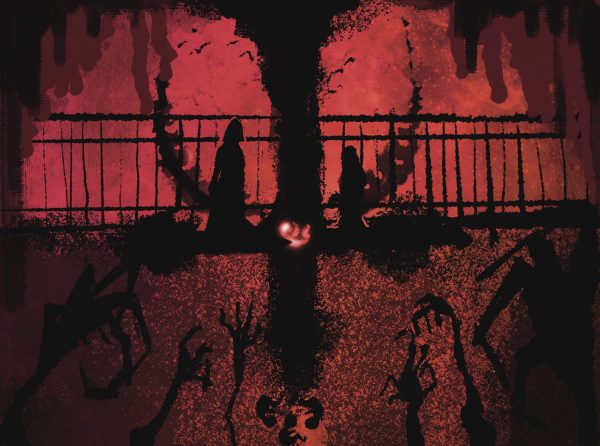Author David Lazar documents lifelong passions in ‘Celeste Holm Syndrome’
Author David Lazar.
“I have Celeste Holm Syndrome.” It’s a brief, funny statement that sits atop a deeper feeling from childhood through adulthood. This type of writing is all over David Lazar’s latest collection of essays aptly titled “Celeste Holm Syndrome: on Character Actors from Hollywood’s Golden Age.”
Lazar writes about Holm and plenty of other character actors who worked during the mid-1900s, looking at the core of character and challenging how people watch movies. Instead of focusing on the characters with the most lines or most iconic lines, by watching the characters who hang in the supporting roles you can learn much more than what meets the eye.
Lazar defines Celeste Holm syndrome in the titular essay as “a permanent chip on my shoulder about Hollywood’s sexually undermining interesting ‘mature’ women when their roles called for economic power or independence.” Lazar explores the impact of the strict rules in the Golden Age, and how Hollywood Studios controlled their stars and supporting actors. He looks at how specific actors and actresses thrived in the sideline roles of great films. The book encourages the reader to keep a more watchful eye on those characters.
“[There was] an absolutely huge stable of character actors back then,” Lazar said in a phone interview. “And there are in fact working and interesting character actors now, but much fewer.”
Lazar’s career has been about building non-fiction writing programs and the education around it. Lazar was a Guggenheim Fellow in 2015 for his work in non-fiction writing. He went to Bennington College in Vermont and got master’s degrees at Stanford University and Syracuse University and finished his doctorate in creative writing and literature at the University of Houston.
A year later, in 1990, he began working at Ohio University, making his way through the ranks of professors. At Ohio, he created the nonfiction writing program from undergraduate through a doctoral program. He also founded the literary magazine Hotel Amerika in 2001. His essays have been published in many literary publications.
Lazar has resided in Chicago since 2006, working as a professor at Columbia College Chicago where he established the MFA and undergraduate programs for nonfiction writing.
“Teaching and writing really coincided for me, you know, rather perfectly,” he said. “The work I do in the class feeds my own intellectual interests. And my work as a mentor of writing has been very, very important to me, many of my students are practicing writers and professors.”
Lazar grew up watching films of the golden age as a child living in Brooklyn. He and his brother would take the bus or train to beautiful historic cinemas where he fell in love with the screen.
“[The Golden Age] is when I grew up and that is when I fell in love with cinema,” he said. And I have tended as a writer to follow my own fascination.”
“Celeste Holm Syndrome” weaves Lazar’s lifelong admiration for these actors with his affection for character, and the short bursts of life we see each day in people passing by. This collection of essays has been in the works for quite a bit. One essay, titled “My Family Romance” appeared in Lazar’s 2003 book “Body of Brooklyn” and was revised for “Celeste Holm Syndrome.”
Lazar has been writing about movies for a long time, but also about the themes these movies cover in life. Themes of gender and parenthood among others have dominated his thinking and teaching as well as his writing.
“I reached a point at which I said to myself, I can really write these essays for many years,” he said. “And my love of character actors is pretty endless. But I like the idea of this grouping, which is actually kind of a short grouping that covers some of the obsessions that I’ve written about, really over and over again about mothers and gender and that kind of thing.”
This collection of essays documents his lifelong passions. Lazar has always been waiting to make this specific collection. When he became a Guggenheim fellow, he wanted to make this originally but decided on something else. “I’ve been working on it for a long time because each of these essays really required me to watch dozens and dozens of movies, and not only watch them but watch them taking notes, so that, I mean, I spend hundreds and hundreds of hours watching movies and taking notes and writing essays.”
The process involved re-watching movies from his childhood, teens and adult life, focusing on different things and digesting and analyzing what makes the characters in these films stand out.
“You know, watching a movie or reading a book, at different ages, is, you know, it’s a really enlightening experience,” Lazar said. “In fact, it’s such a strange or even a disappointing experience. Things you are in love with when you’re 25 sometimes lose a bit of their luster when you’re 50 or 60.”
Lazar has always taken his love for cinema into his life and his work. “Movies have figured in my work since the beginning really since my first book Body of Brooklyn. But I think almost everything I have written has some allusion to movies.”
Essay topics throughout the book include melancholy, comedy and pain, movie mothers and more — all themes that Lazar has continually reflected on in his work as a writer. The titular essay was one that kind of culminated in his mind. “Celeste Holm Syndrome” is about Celeste Holm, the original Ado Annie of “Oklahoma!” but also about how women were treated, and have continued to be treated in Hollywood.
“Outrage has always been essential to who I am, with a little bit of self-righteousness tossed in,” Lazar said. “That essay seemed to represent me quite well.”
Lazar is continuously working in higher education as well as editing and publishing non-fiction material. “I don’t think of it as my day job,” he said. “You know, I think of it as my avocation. And you know, it’s been a very joyful experience for me. And it’s a great thing to be able to actually practice what you love doing, the two just blend rather seamlessly.”





![DePaul sophomore Greta Atilano helps a young Pretty Cool Ice Cream customer pick out an ice cream flavor on Friday, April 19, 2024. Its the perfect job for a college student,” Atilano said. “I started working here my freshman year. I always try to work for small businesses [and] putting back into the community. Of course, interacting with kids is a lot of fun too.](https://depauliaonline.com/wp-content/uploads/2024/04/ONLINE_1-IceCream-600x400.jpg)











